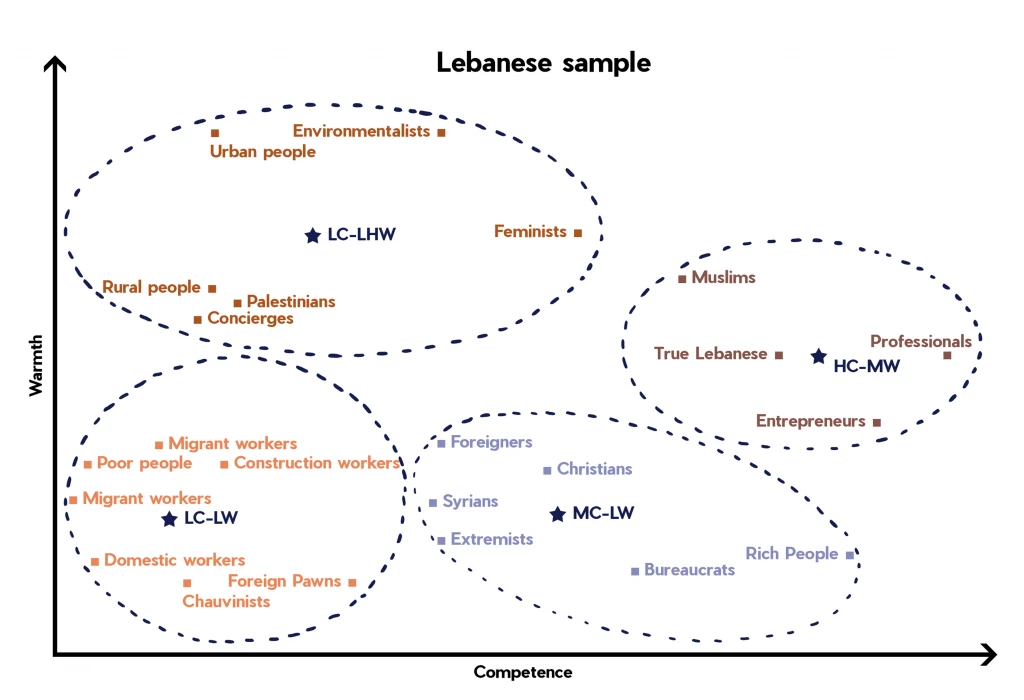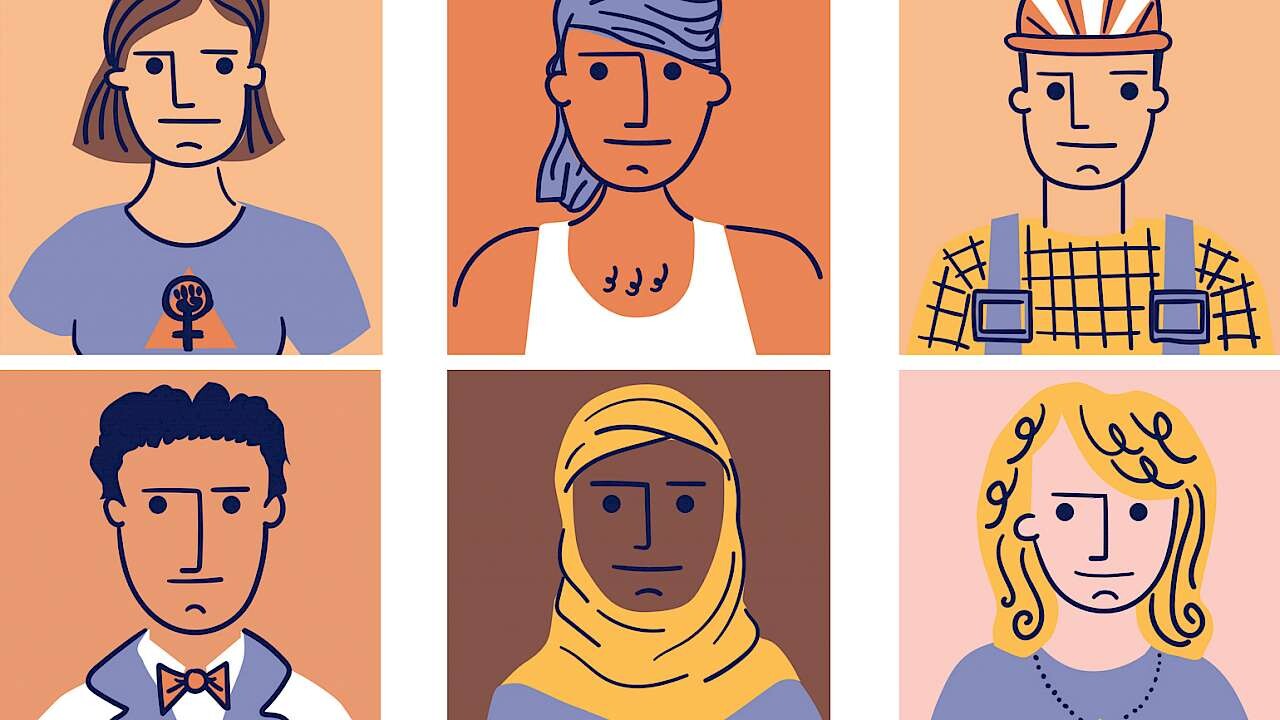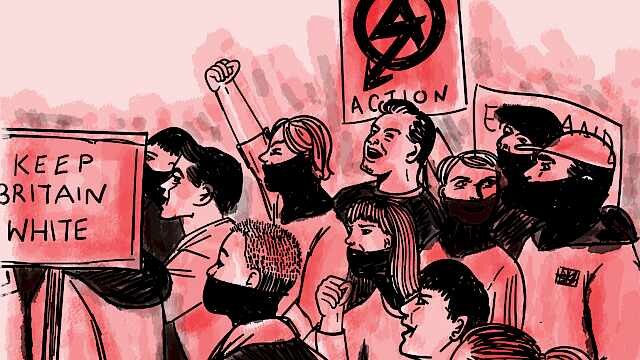Planning for an interview requires preparation for impression management. This includes being strategic about how the interviewer will manage the interviewee's impressions of them and also vice versa: how the interviewee might manage the impression the interviewer forms of them. These first impressions are formed quickly, are hard to change, and will be influenced by stereotypes – that is, by what we expect an individual to be like depending on their social or cultural group. An expert interviewer will find strategies to ensure that first impressions work to his or her favour. Anticipating stereotypes might be part of that effort.
Stereotype Content Model
The Stereotype Content Model (SCM) describes how individuals within a culture characterise social groups in their own culture in terms of warmth and competence. Warmth (are they friendly or not?) and competence (can they harm me or help me?) are two characteristics about which we judge people quickly.
An SCM for Lebanon (from 2013) is shown in Figure 1; the scale for both measures goes from low to high for each axis. The groups within each SCM are identified by members of that country. Individuals are asked, 'What various types of people do you think today’s society categorises into groups (i.e. based on ethnicity, race, gender, occupation, ability, etc.)?
 Figure 1. A Stereotype Content Model for Lebanon (2013).
Figure 1. A Stereotype Content Model for Lebanon (2013).
Please list between eight and 16 such groups.’ Then they are instructed, with respect to each group, ‘As viewed by society, how warm are members of this group?’ And, ‘As viewed by society, how competent are members of this group?’
As can be seen, Lebanese are likely to view ‘professionals’ with warmth and to assume that they are generally competent; alternatively, they are likely to view ‘domestic workers’ and ‘refugees’ as cold and incompetent. Rich people and bureaucrats are seen as competent but cold; urban people and environmentalists are seen as warm but relatively incompetent.
Groups falling in the upper right-hand quadrant are reference groups within that culture; that is, groups that serve as normative standards for social comparison and often, social aspiration: these are the groups we want to belong to and often self-identify with.
SCMs can serve as tools for predicting group stereotypes within a culture and for comparing these stereotypes across cultures. An interviewer thus might use an SCM to aid in predicting a subject’s view of themselves and of the interviewer.
Using the Lebanese SCM, for example, someone interviewing a Lebanese subject might want to emphasise their role as a professional and downplay that they are any kind of bureaucrat or part of an elite group such as the rich.
The interviewer might also encourage the Lebanese subject’s view of themselves as a ‘true Lebanese’; that is, as part of a Lebanese reference group. This is because emotions directed towards groups that fall in the upper right-hand quadrant of SCMs are admiration and pride. In contrast, the emotions directed towards groups falling in the lower left-hand quadrant are contempt and disgust; pity is directed towards groups in the upper left-hand quadrant, and envy towards those groups in the lower right-hand quadrant.
Encouraging self-efficacy and a sense of autonomy – that is, a sense of self-pride in the interviewee – is important to the development and maintenance of rapport between the interviewer and interviewee, and has been shown to increase the likelihood of the interviewee providing useful information. Thus, making the interviewee feel good about themselves should be useful to information elicitation.
Making the interviewee feel good about themselves should be useful to information elicitation
In addition, research has shown that the four quadrants of SCMs not only elicit different emotions but that these emotions are associated with four discrete patterns of behaviour: helping (upper right-hand quadrant), harm (lower right-hand quadrant), passive cooperation and protection (upper left-hand quadrant) and harassment and exclusion (lower left-hand quadrant). Obviously, helping is the behaviour an interviewer wants to encourage from their subject.
SCMs for a number of other countries can be found at www.fiskelab.org/cross-cultural-wc-maps.
Warmth and competence
What should an interviewer do when the subject comes from a country for which there is no readily available SCM? One clue is in the fact that reference groups are what individuals aspire to be and identify with.
Across many countries, reference groups sit in the upper right-hand quadrant and are viewed as both warm and competent. Therefore, the interviewer should engage in behaviours that display both warmth and competence: showing empathy and genuine regard (warmth), as well as an understanding of the interview process and the situation in which the subject finds themselves (competence). Doing so should increase the likelihood that the interviewer will be viewed as warm and competent, which will in turn encourage the subject to be helpful.
As many practitioners may recognise, this model is based on how we are seen by other parties, not necessarily who we actually are. Thus what you say, how you say it, what you wear and items you carry can influence the person to see you as warm and competent – someone they will help, by opening up and disclosing information.
Read more
- Susan Fiske, Amy Cuddy, Peter Glick & Jun Xu. 2002. A model of often mixed stereotype content: competence and warmth respectively follow from perceived status and competition. Journal of Personality and Social Psychology, 82(6): 878-902. Available at: https://goo.gl/kRvWqK
- Susan Fiske, Amy Cuddy and Peter Glick. 2002a. Emotions up and down: Intergroup emotions result from perceived status and competition. In D. M. Mackie and E. R. Smith Eds., From Prejudice to Intergroup Emotions: Differentiated Reactions to Social Groups, pp. 247–264. Philadelphia, PA: Psychology Press. Available at: https://goo.gl/GVgwyh
- Amy Cuddy, Susan Fiske & Peter Glick. 2008. Warmth and competence as universal dimensions of social perception: The Stereotype Content Model and the BIAS map. In M. Zanna Ed., Advances in Experimental Social Psychology 40. Cambridge MA: Academic Press
Copyright Information
As part of CREST’s commitment to open access research, this text is available under a Creative Commons BY-NC-SA 4.0 licence. Please refer to our Copyright page for full details.
IMAGE CREDITS: Copyright ©2024 R. Stevens / CREST (CC BY-SA 4.0)






